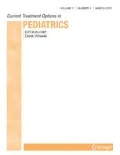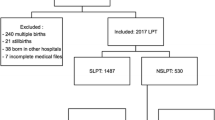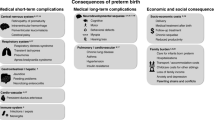Opinion statement
The goal of this review is to define gestational age categories and discuss the epidemiology, complications, strategies for prevention, and management of late preterm infants. Late preterm (i.e., 34 to 36 weeks of gestation) birth is prevalent (8.0% of all live births in the USA in 2013) and is associated with increased infant mortality and morbidity. Although most late preterm births are medically indicated, elective early delivery plays a role. Policies limiting elective births at gestations less than 39 weeks and guidance for timing of indicated late preterm birth have reduced late preterm births. Late preterm neonates frequently require neonatal intensive care and should be monitored throughout life for developmental, educational, psychosocial, and medical morbidities. Prevention of late preterm births is key to reduction in mortality and morbidity. Continued prevention efforts and implementation of best practices may decrease acute and long-term complications of late preterm birth.
Similar content being viewed by others
References and Recommended Reading
Papers of particular interest, published recently, have been highlighted as: • Of importance •• Of major importance
Raju TNK et al. Optimizing care and outcome for late-preterm (near-term) infants: a summary of the workshop sponsored by the National Institute of Child Health and Human Development. Pediatrics. 2006;118(3):1207–14.
Raju TNK. Epidemiology of late preterm (near-term) births. Clin Perinatol. 2006;33:751–63.
Wang ML, Dorer DJ, Fleming MP, Catlin EA. Clinical outcomes of near-term infants. Pediatrics. 2004;114:372–6.
Davidoff MJ, Dias T, Damus K, et al. Changes in the gestational age distribution among US singleton births: impact on rates of late preterm birth 1992 to 2002. Semin Perinatol. 2006;30:8–15.
Engle WA, Tomashek KM, Wallman C. Committee on fetus and newborn “late-preterm” infants: a population at risk. Pediatrics. 2007;120:1390–401.
Spong CY. Defining “term” pregnancy: recommendations from the defining “term” pregnancy workgroup. JAMA. 2013;309(23):2445–6.
World Health Organization. Preterm birth. www.who.int. Accessed 8.8.16
Tyson JE, Parikh NA, Langer J, Green C, Higgins RD. for the National institute of Child Health and Human Development neonatal Research Network. Intensive care for extreme prematurity—moving beyond gestational age. N Engl J Med. 2008;358(10):1672–81.
Matthews TJ, MacDorman MF, Thoma ME. Infant mortality statistics from the 2013 period linked birth/infant death data set. National Vital Statistics Reports 64(9). National Center for Health Statistics.: Hyattsville, MD; 2015.
Engle WA. Morbidity and mortality in late preterm and early term newborns: a continuum. Clin Perinatol. 2011;38(3):493–516.
Mathews TJ, MacDorman MF. Infant mortality statistics from the 2006 period linked birth/infant death data set. National Vital Statistic Reports; vol 58 no 17. Hyattsville, MD: National Center for Health Statistics, 2010.
Tomashek KM, Shapiro-Mendoza CK, Davidoff MJ, Petrini JR. Differences in mortality between late preterm and term singleton infants in the United States, 1995–2002. J Pediatr. 2007;151:450–6.
Thomashek KM, Shapiro-Mendoza CK, Weiss J, et al. Early discharge among late preterm and term newborns and risk of neonatal morbidity. Semin Perinatol. 2006;30(2):61–8.
Crump C, Sundquist K, Sundquist J, Winkleby MA. Gestational age at birth and mortality in young adulthood. JAMA. 2011;306(11):1233–40.
Consortium on Safe Labor. Respiratory morbidity in late preterm births. JAMA. 2010;304:419–25.
• Boyle EM, Johnson S, Manktelow, et al. Neonatal outcomes and delivery of care for infants born later preterm or moderately preterm: a prospective population-based study. Arch Dis Child Fetal Neonatal Ed. 2015;100:F479–85. Significance: Knowledge that late preterm infants managed in normal nursery sites require significantly more intervention than term infants is important for planning for service needs.
Shapiro-Mendoza CK, Tomashek KM, Kotelchuck M, et al. Effect of late-preterm birth and maternal medical conditions on newborn morbidity risk. Pediatrics. 2008;121:e223–32.
•• Gyamfi-Bannerman C, Thom EA, Blackwell SC, et al. Antenatal betamethasone for women at risk for late preterm delivery. N Engl J Med. 2016;374:1311–20. Significance: strong evidence for use of antenatal corticosteroids for women at risk for late preterm delivery.
Shah PS, Hakak H, Mohamed A, Shah J, Yung J, Kelly E. Oxygen saturation profile in late preterm and term infants: a prospective cohort study. J Perinatol. 2014;34:917–20.
Hunt DE. Ontogeny of autonomic regulation in late preterm infants born at 34 to 37 weeks postmenstrual age. Semin Perinatol. 2006;30:73–6.
McIntire DD, Leveno KJ. Neonatal mortality and morbidity rates in late preterm births compared with births at term. Obstet Gynecol. 2008;111:35–41.
Lapillonne A. Feeding the preterm infant after discharge. In Koletzko B, Poindexter B, Uauy R (editors) Nutritional Care of Preterm Infants: Scientific Basis and Practical Guidelines. World Rev Nutr Diet. Basel, Karger, 2014:110:264–277
Lapillonne A, O”Connor DL, Wang D, Rigo J. Nutritional recommendations for the late-preterm infant and the preterm infant after hospital discharge. J Pediatrics. 2013;162:S90–100.
Briere CE, Lucas R, McGrath JM, Lussier M, Brownell E. Establishing breastfeeding with the late preterm infant in the NICU. J Obstet Gynecol Neonatal Nurs. 2015;44(1):102–13.
Hwang SS, Barfield WD, Smith A, et al. Discharge timing, outpatient follow-up, and home care of late-preterm and early-term infants. Pediatrics. 2013;132(1):101–8.
Bird TM, Bronsein JM, Hall RW, Lowery CL, Nugent R, Mays GP. Late preterm infants: birth outcomes and health care utilization in the first year. Pediatrics. 2010;126:e311–9.
McLaurin KK, Hall CB, Jackson EA, et al. Persistence of morbidity and cost differences between late-preterm and term infants during the first year of life. Pediatrics. 2009;123:653–9.
Laughon SK, Reddy UM, Sun L, Zhang J. Precursors for late preterm birth in singleton gestations. Obstet Gynecol. 2010;116:1047–55.
Pulver LS, Denney JM, Silver RM, Young PC. Morbidity and discharge timing of late preterm newborns. Clin Pediatr. 2010;49:1061–7.
Aly H, Mohamed E, Said L, Mohamed M. Factors affecting length of stay in late preterm infants: a US national database study. J Maternal Fetal Neonatal Med. 2015;28(5):598–604.
Jain S, Cheng J. Emergency department visits and rehospitalizations in late preterm infants. Clin Perinatol. 2006;33:935–45.
Moster D, Lie RT, Markestad T. Long-term medical and social consequences of preterm birth. N Engl J Med. 2008;359:262–73.
Goyal NK, Fiks AG, Lorch SA. Association of late-preterm birth with asthma in young children: practice-based study. Pediatrics. 2011;128:e830–8.
Helfrich A, Nylund CM, Eberly MD, Eide MB, Stagliano DR. Healthy late-preterm infants born 33-36 + 6 weeks gestational age have higher risk for respiratory syncytial virus hospitalization. Early Hum Dev. 2015;91:541–6.
• Nagasaka M, Morioka I, Yokota T, et al. Incidence of short stature at 3 years of age in later preterm infants: a population-based study. Arch Dis Child. 2015;100:250–4. Significance: New information of negative impact of late preterm birth on growth during childhood.
Crump C, Sundquist K, Winkleby MA, Sundquist J. Risk of diabetes among young adults born preterm in Sweden. Diabetes Care. 2011;34:1109–13.
• Walsh JM, Doyle LW, Anderson PJ, Lee KJ, Cheong JLY. Moderate and late preterm birth: effect on brain size and maturation at term-equivalent age. Radiology. 2014;273(1):232–40. Significance: Impact of late preterm birth on brain size.
• Kelly CE, Cheong JLY, Fam LG, et al. Moderate and late preterm infants exhibit widespread brain white matter microstructure alterations at term-equivalent age relative to term-born controls. Brain Imaging Behav. 2016;10(1):41–9. Significance: Impact of late preterm birth on white matter development in the brain.
Degnan AJ, Wisnowski JL, Choi S, et al. Altered structural and functional connectivity in late preterm preadolescence: an anatomic seed-based study of resting state networks related to the posteromedial and lateral parietal cortex. PLoS One. 2015;10(6):3130686. Significance: Negative impact on brain development of late preterm birth in preadolescent children.
• Guy A, Seaton SE, Boyle EM, et al. Infants born late/moderately preterm are at increased risk for a positive autism screen at 2 years of age. J Pediatrics. 2015;166:269–75. Significance: Potential association of late preterm birth and autism.
Petrini JR, Dias T, McCormick MC, Massolo ML, Green NS, Escobar GJ. Increased risk of adverse neurological and development for late preterm infants. J Pediatr. 2009;154:169–76.
Hirvonen M, Ojala R, Korhonen P, et al. Cerebral palsy among children born moderately and late preterm. Pediatrics. 2014;134(6):e1584–93.
Johnson S, Evans TA, Draper ES, et al. Neurodevelopmental outcomes following late and moderate prematurity: a population-based cohort study. Arch Dis Child Fetal Neonatal Ed. 2015;100:F301–8.
Shapiro-Mendoza C, Kotelchuck M, Barfield W, et al. Enrollment in early intervention programs among infants born later preterm, early term and term. Pediatrics. 2013;132:e61–9.
• Heinonen K, Eriksson JG, Kajantie E, et al. Late-preterm birth and lifetime socioeconomic attainments: the Helsinki birth cohort study. Pediatrics. 2013;132(4):647–55. Significance: Adult outcomes are negatively impacted by late preterm birth.
•• Heinonen K, Eriksson JG, Lahti J, et al. Late preterm birth and neurocognitive performance in late adulthood: a birth cohort study. Pediatrics. 2015;135(4):e818–25. Significance: Adult outcomes are negatively impacted by late preterm birth.
Morse SB, Zheng H, Tang Y, Roth J. Early school-age outcomes of late preterm infants. Pediatrics. 2009;123:e62–e629.
Boylan J, Alderdice FA, McGowan JE, Crain S, Perra O, Jenkins J. Behavioural outcomes at 3 years of age among later preterm infants admitted to neonatal intensive care: a cohort study. Arch Dis Child Fetal Neonatal Ed. 2014;99:F359–65.
Eryigit-Madzwamuse S, Wolke D. Attention problems in relation to gestational age at birth and smallness for gestational age. Early Hum Dev. 2015;91:131–8.
Rogers CE, Lenze SN, Luby JL. Late preterm birth, maternal depression, and risk of preschool psychiatric disorders. J Am Acad Child Adolesc Psychiatry. 2013;52(3):309–18.
Lindstrom K, Lindblad F, Hjern A. Psychiatric morbidity in adolescents and young adults born preterm: a Swedish national cohort study. Pediatrics. 2009;123(1):e47–53.
Linnet KM, Wisborg K, Agerbo E, et al. Gestational age, birthweight, and the risk of hyperkinetic disorder. Arch Dis Child. 2006;91:655–60.
Harris MN, Voigt RG, Barberesi WJ, et al. ADHD and learning disabilities in former late preterm infants; a population-based birth cohort. Pediatrics. 2013;132:e630–6.
Lindstrom K, Lindbladh B, Haglund B, Hjern A. Preterm infants as young adults: a Swedish national cohort study. Pediatrics. 2007;120:70–7.
• Newnham JP, Dickinson JE, Hart RJ, Pennell CE, Arrese CA, Keelan JA. Strategies to prevent preterm birth. Front Immunol. 2014;584(5):1–12. Significance: Informative review of interventions to reduce late preterm birth.
Simhan HN, Berghella V, Iams JD. Preterm labor and birth. In: Creasy RK, Resnik R, Iams JD, Lockwood CJ, Moore TR, Greene MF, editors. Creasy and Resnik’s maternal-fetal medicine. 7th ed. PA.: Elsevier Saunders Philadelphia; 2014. p. 624–53.
Robinson JN, Norwitz ER, Lockwood CJ, Barss VA. Preterm birth: risk factors and interventions for risk reduction. UpToDate. www.uptodate.com. Accessed 8.10.2016.
Hamilton BE, Martin JA, Osterman MJK, et al. Births: final data for 2014. National vital statistics reports; vol 64 no 12. Hyattsville, MD: National Center for Health Statistics. 2015.
Oshiro BT, Henry E, Wilson J, Branch DW, Varner MW. Decreasing elective deliveries before 39 weeks of gestation in an integrated health care system. Obstet Gynecol. 2009;113(4):804–11.
Clark SL, Frye DR, Meyers JA, et al. Reduction in elective delivery at < 39 weeks of gestation: comparative effectiveness of 3 approaches to change and the impact on neonatal intensive care admission and stillbirth. Am J Obstet Gynecol. 2010;203(449):e441–6.
Ehrenthal EB, Hoffman MK, Jiang X, Ostrum G. Neonatal outcomes after implementation of guidelines limiting elective delivery before 39 weeks of gestation. Obstet Gynecol. 2011;118(5):1047–55.
Spong CY, Mercer BM, D’Alton M, Kilpatrick S, Blackwell S, Saade G. Timing of indicated late-preterm and early-term birth. Obstet Gynecol. 2011;118(2 Pt 1):323–33.
Author information
Authors and Affiliations
Corresponding author
Ethics declarations
Conflict of Interest
Rebecca Rose declares that she has no conflict of interest.
William A. Engle declares that he has no conflict of interest.
Human and Animal Rights and Informed Consent
This article does not contain any studies with human or animal subjects performed by any of the authors.
Additional information
This article is part of the Topical Collection on Neonatology
Rights and permissions
About this article
Cite this article
Rose, R., Engle, W.A. Optimizing Care and Outcomes for Late Preterm Neonates. Curr Treat Options Peds 3, 32–43 (2017). https://doi.org/10.1007/s40746-017-0074-z
Published:
Issue Date:
DOI: https://doi.org/10.1007/s40746-017-0074-z




